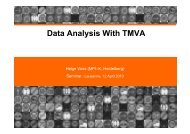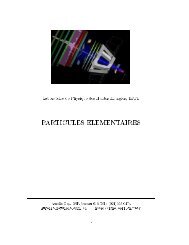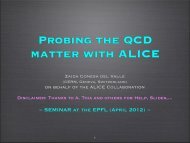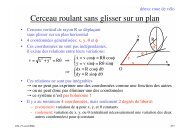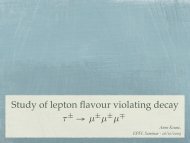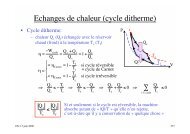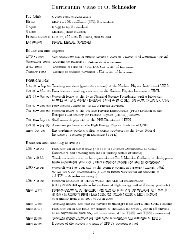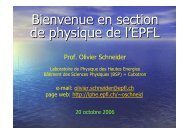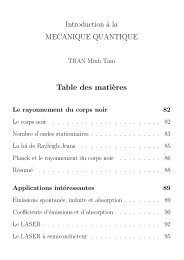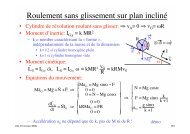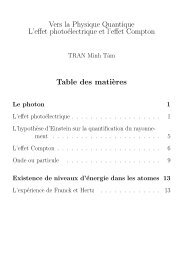LHCb - Minimum Bias physics plans and MC framework - EPFL
LHCb - Minimum Bias physics plans and MC framework - EPFL
LHCb - Minimum Bias physics plans and MC framework - EPFL
Create successful ePaper yourself
Turn your PDF publications into a flip-book with our unique Google optimized e-Paper software.
<strong>LHCb</strong> - <strong>Minimum</strong> <strong>Bias</strong> <strong>physics</strong> <strong>plans</strong><br />
<strong>and</strong> <strong>MC</strong> <strong>framework</strong><br />
7th Meeting of the<br />
<strong>MC</strong>net European Network, CERN January 2010<br />
Raluca Mures¸an<br />
<strong>EPFL</strong><br />
on behalf of the <strong>LHCb</strong> collaboration<br />
<strong>MC</strong>Net CERN R. Mures¸an, <strong>LHCb</strong> report – p.1/30
Outline<br />
<strong>LHCb</strong> detector <strong>and</strong> rapidity coverage<br />
Plans for <strong>Minimum</strong> <strong>Bias</strong> studies<br />
<strong>MC</strong> <strong>framework</strong> <strong>and</strong> generators @ <strong>LHCb</strong><br />
Summary<br />
<strong>MC</strong>Net CERN R. Mures¸an, <strong>LHCb</strong> report – p.2/30
<strong>LHCb</strong> detector<br />
<strong>LHCb</strong> detector is fully installed, first data were recorded <strong>and</strong><br />
the analysis is ongoing.<br />
<strong>MC</strong>Net CERN R. Mures¸an, <strong>LHCb</strong> report – p.3/30
<strong>LHCb</strong> detector<br />
<strong>LHCb</strong> detector is fully installed, first data were recorded <strong>and</strong><br />
the analysis is ongoing.<br />
We are eagerly waiting for new data at<br />
higher energies<br />
<strong>MC</strong>Net CERN R. Mures¸an, <strong>LHCb</strong> report – p.3/30
y<br />
5m<br />
Vertex<br />
Locator<br />
TT<br />
Magnet<br />
5m<br />
T1 T2T3<br />
<strong>LHCb</strong> detector<br />
RICH2<br />
ECAL<br />
SPD/PS<br />
M1<br />
HCAL<br />
M2<br />
M3<br />
M4 M5<br />
10m 15m 20m<br />
z<br />
Dedicated b-<strong>physics</strong><br />
experiment: CP violation<br />
<strong>and</strong> rare decays<br />
Forward single arm<br />
spectrometer - large <strong>and</strong><br />
correlated b ¯ b quark<br />
production in the forward<br />
region.<br />
Coverage:<br />
15-300(250) mrad<br />
<strong>MC</strong>Net CERN R. Mures¸an, <strong>LHCb</strong> report – p.4/30
y<br />
5m<br />
Vertex<br />
Locator<br />
TT<br />
Magnet<br />
5m<br />
T1 T2T3<br />
<strong>LHCb</strong> detector<br />
RICH2<br />
ECAL<br />
SPD/PS<br />
M1<br />
HCAL<br />
M2<br />
M3<br />
M4 M5<br />
10m 15m 20m<br />
z<br />
For the first analysis we<br />
rely on the tracking<br />
detectors.<br />
Same data will be used<br />
for PID calibration using<br />
very clean samples of<br />
D ∗ , Λ <strong>and</strong> KS, reconstructed<br />
using only tracking<br />
information.<br />
<strong>MC</strong>Net CERN R. Mures¸an, <strong>LHCb</strong> report – p.4/30
First data analysis<br />
corresponds to 100 events/process<br />
Inclusive<br />
distributions<br />
<strong>MC</strong>Net CERN R. Mures¸an, <strong>LHCb</strong> report – p.5/30
First data analysis<br />
corresponds to 100 events/process<br />
Inclusive<br />
distributions<br />
Strangeness<br />
production<br />
<strong>MC</strong>Net CERN R. Mures¸an, <strong>LHCb</strong> report – p.5/30
First data analysis<br />
corresponds to 100 events/process<br />
Inclusive<br />
distributions<br />
Strangeness<br />
production<br />
Charm signals<br />
<strong>MC</strong>Net CERN R. Mures¸an, <strong>LHCb</strong> report – p.5/30
First data analysis<br />
corresponds to 100 events/process<br />
Inclusive<br />
distributions<br />
Strangeness<br />
production<br />
Charm signals<br />
J/ψ production<br />
<strong>MC</strong>Net CERN R. Mures¸an, <strong>LHCb</strong> report – p.5/30
First data analysis<br />
corresponds to 100 events/process<br />
Inclusive<br />
distributions<br />
Strangeness<br />
production<br />
Charm signals<br />
J/ψ production<br />
<strong>MC</strong>Net CERN R. Mures¸an, <strong>LHCb</strong> report – p.5/30<br />
....
First data analysis<br />
corresponds to 100 events/process<br />
Underst<strong>and</strong>ing <strong>and</strong> calibrating our<br />
detector<br />
<strong>MC</strong> tuning <strong>and</strong> validation<br />
QCD <strong>physics</strong> studies<br />
Inclusive<br />
distributions<br />
Strangeness<br />
production<br />
Charm signals<br />
J/ψ production<br />
....<br />
Stepping stone towards reconstruction of<br />
interesting charm <strong>and</strong> beauty hadrons that<br />
have as daughters KS, Λ, J/ψ, D 0 ...,<br />
in particular for charm <strong>and</strong> beauty baryon<br />
studies (Λ)<br />
<strong>MC</strong>Net CERN R. Mures¸an, <strong>LHCb</strong> report – p.5/30
Pseudorapidity range<br />
Studies of the inclusive distributions at <strong>LHCb</strong> particularly<br />
interesting because of the unique rapidity range coverage.<br />
ATLAS CMS+TOTEM<br />
ALICE <strong>LHCb</strong><br />
tracking, ECAL, HCAL, counters lumi, muon, hadron PID<br />
<strong>MC</strong>Net CERN R. Mures¸an, <strong>LHCb</strong> report – p.6/30
(All) Inclusive measurements<br />
Models used by Pythia <strong>and</strong> other generators were tuned mainly on<br />
Tevatron data (LEP <strong>and</strong> SPS also used).<br />
The agreement between models is broken at LHC, due to different<br />
energy extrapolations. The models disagree even more in the <strong>LHCb</strong><br />
kinematical region, also η extrapolation.<br />
Even basic distributions such as charged particle multiplicity can help<br />
for the <strong>MC</strong> tuning, e.g. collection of minimum bias distributions of<br />
interest: http://home.fnal.gov/ sk<strong>and</strong>s/leshouches-plots/qcdplots-houches.pdf.<br />
The benchmark distributions variation range is constrained<br />
−→ “New (QCD) <strong>physics</strong>” see Rick Field Introduction to UE <strong>and</strong> MB studies.<br />
<strong>MC</strong>Net CERN R. Mures¸an, <strong>LHCb</strong> report – p.7/30
(All) Inclusive measurements<br />
Particle ratios: dn+ /dη<br />
dn − /dη ,<br />
dn + /dpT<br />
dn − /dpT .....<br />
can be done with very low integrated luminosity;<br />
vital for underst<strong>and</strong>ing charge asymmetries;<br />
Inclusive distributions: dn<br />
dX , d2n dXdY with X, Y = pT , η, φ ...<br />
distribution to be measured for: all charged particles,<br />
separately for positives <strong>and</strong> negatives;<br />
essential for the underst<strong>and</strong>ing of our detector;<br />
important input for tuning of (MB) Monte Carlo generators;<br />
joining the efforts of all LHC communities.<br />
<strong>MC</strong>Net CERN R. Mures¸an, <strong>LHCb</strong> report – p.8/30
Strangeness production<br />
No valence strange quarks in the initial state, strangeness probes<br />
fragmentation field in a unique way.<br />
Non-diff, prompt Λ <strong>and</strong> ¯Λ.<br />
¯Λ/Λ<br />
1.05<br />
1<br />
0.95<br />
0.9<br />
0.85<br />
<strong>LHCb</strong> <strong>MC</strong> generator level 5 TeV/beam<br />
<strong>LHCb</strong><br />
<strong>LHCb</strong>+S0APro<br />
<strong>LHCb</strong>+P0<br />
<strong>LHCb</strong>+PX<br />
<strong>LHCb</strong>+P3<br />
<strong>LHCb</strong>+P6<br />
<strong>LHCb</strong>+PNOCR<br />
<strong>LHCb</strong>+PSoft<br />
<strong>LHCb</strong>+PHard<br />
0.8<br />
−10 −8 −6 −4 −2 0 2 4 6 8 10<br />
η<br />
The distributions were<br />
obtained by varying consistently<br />
PYTHIA parameters<br />
related to: parton distribution<br />
functions, initial state radiation,<br />
final state radiation,<br />
beam remnant, hadronization,<br />
underlying event,<br />
color reconnection see<br />
P. Sk<strong>and</strong>s on Perugia tunes<br />
on top of <strong>LHCb</strong> specific <strong>MC</strong><br />
tunings.<br />
<strong>MC</strong>Net CERN R. Mures¸an, <strong>LHCb</strong> report – p.9/30
Strangeness production<br />
No valence strange quarks in the initial state, strangeness probes<br />
fragmentation field in a unique way.<br />
Non-diff, prompt Λ <strong>and</strong> ¯Λ.<br />
¯Λ/Λ<br />
1.05<br />
1<br />
0.95<br />
0.9<br />
0.85<br />
<strong>LHCb</strong> <strong>MC</strong> generator level 5 TeV/beam<br />
<strong>LHCb</strong><br />
<strong>LHCb</strong>+S0APro<br />
<strong>LHCb</strong>+P0<br />
<strong>LHCb</strong>+PX<br />
<strong>LHCb</strong>+P3<br />
<strong>LHCb</strong>+P6<br />
<strong>LHCb</strong>+PNOCR<br />
<strong>LHCb</strong>+PSoft<br />
<strong>LHCb</strong>+PHard<br />
0.8<br />
−10 −8 −6 −4 −2 0 2 4 6 8 10<br />
η<br />
Up to 5% difference in<br />
the <strong>LHCb</strong> kinematic<br />
region, only 1% for the<br />
central detectors;<br />
Baryon number<br />
transport: get as close<br />
to the beam as possible!<br />
And this is only what<br />
(a bunch of) theorists<br />
thought of −→<br />
“New <strong>physics</strong>” might be<br />
round the corner<br />
<strong>MC</strong>Net CERN R. Mures¸an, <strong>LHCb</strong> report – p.9/30
V 0 selection<br />
Look to the prompt Λ, ¯Λ, KS (i.e. produced at the primary vertex or<br />
coming from the electromagnetic or a strong decay of a prompt<br />
particle in non-diffractive events);<br />
Use only tracking information (no PID) <strong>and</strong> very well measured long<br />
tracks that are leaving signal in VELO, TT <strong>and</strong> T1-T3.<br />
Selected V 0 kinematic range<br />
[GeV]<br />
T<br />
P<br />
6<br />
4<br />
2<br />
0<br />
0 2 4 6 8<br />
η(<br />
Λ)<br />
[GeV]<br />
<strong>LHCb</strong> <strong>MC</strong> 5 TeV/beam 6 <strong>LHCb</strong> <strong>MC</strong> 5 TeV/beam <strong>LHCb</strong> <strong>MC</strong> 5 TeV/beam<br />
6<br />
T<br />
P<br />
4<br />
2<br />
0<br />
0 2 4 6 8<br />
η(<br />
Λ)<br />
[GeV]<br />
T<br />
P<br />
4<br />
2<br />
0<br />
0 2 4 6 8<br />
η(K<br />
<strong>MC</strong>Net CERN R. Mures¸an, <strong>LHCb</strong> report – p.10/30<br />
)<br />
S
V 0 - Observables of interest<br />
η, y <strong>and</strong> pT distributions of V 0 , since models generally<br />
agree on the total amount of strangeness but do not agree<br />
on its distribution.<br />
nr of KS/charged particle multiplicity<br />
meson/baryon ratio pT distributions<br />
antibaryon/baryon ratio η, y distributions.<br />
...<br />
Ratios are good c<strong>and</strong>idates for first measurements: most systematics<br />
cancel, no luminosity measurement needed<br />
<strong>MC</strong>Net CERN R. Mures¸an, <strong>LHCb</strong> report – p.11/30
¯Λ/Λ ratio - <strong>MC</strong> 5 TeV<br />
Fit of the mass plots in each η bin → nr. the signal <strong>and</strong> background events;<br />
<strong>LHCb</strong> <strong>MC</strong> 5 TeV/beam <strong>LHCb</strong> <strong>MC</strong> 5 TeV/beam<br />
Λ 3.5
A glimpse to the first data<br />
<strong>LHCb</strong> very preliminary — Ks <strong>and</strong> Λ 450 GeV/beam<br />
m + - π π<br />
c<strong>and</strong>idates/2 MeV<br />
250<br />
200<br />
150<br />
100<br />
50<br />
(<strong>LHCb</strong> 2009 data, preliminary)<br />
Integral 2045<br />
χ 2 / ndf<br />
121.65 / 95<br />
Prob 0.034031<br />
constant 17.704 ± 1.347<br />
slope -0.025753 ± 0.002561<br />
N signal<br />
1079.6 ± 35.3<br />
m 497.34 ± 0.15<br />
σ m<br />
4.3373 ± 0.1396<br />
0<br />
400 420 440 460 480 500 520 540 560 580 600<br />
[MeV]<br />
m + -<br />
π π<br />
m +/- -/+<br />
p π<br />
c<strong>and</strong>idates/1 MeV<br />
100<br />
80<br />
60<br />
40<br />
20<br />
Integral 1019<br />
χ 2 / ndf<br />
137.5 / 95<br />
Prob 0.0028713<br />
constant 1.4664 ± 0.0619<br />
threshold 1075.3 ± 0.9<br />
N signal 257.61 ± 19.43<br />
m<br />
σ m<br />
1115.6 ± 0.1<br />
1.3985 ± 0.1323<br />
Ready for exciting <strong>physics</strong> results in 2010.<br />
(<strong>LHCb</strong> 2009 data, preliminary)<br />
0<br />
1060 1070 1080 1090 1100 1110 1120 1130 1140 1150 1160<br />
[MeV]<br />
<strong>MC</strong>Net CERN R. Mures¸an, <strong>LHCb</strong> report – p.13/30<br />
m +/- -/+<br />
p π
J/ψ production<br />
Given the large cross-section of J/ψ production large data<br />
samples will be available already in the first days of LHC<br />
running.<br />
Use the J/ψ sample to measure the cross section for<br />
prompt <strong>and</strong> bb production:<br />
pp → X + (ψ(2S),χc0,1,2,... → X)J/ψ<br />
pp → X + bb(b/b → J/ψX)<br />
These cross-sections are important for later analysis steps<br />
in <strong>LHCb</strong>:<br />
Assess event yields,<br />
Underst<strong>and</strong> muon trigger rates,<br />
Necessary input for branching fraction measurements.<br />
<strong>MC</strong>Net CERN R. Mures¸an, <strong>LHCb</strong> report – p.14/30
J/ψ production<br />
J/ψ prompt production not completely understood<br />
The Colour Octet Model reproduces the pT spectrum measured at<br />
Tevatron, but not the production polarization (ր pT not observed).<br />
Other models also predict the same pT spectrum but no polarization.<br />
Unique <strong>LHCb</strong> η coverage where theoretical<br />
predictions are less accurate.<br />
<strong>LHCb</strong> <strong>MC</strong> 4 TeV/beam<br />
19M MB evts.<br />
5 pb −1 at √ s =8 TeV,<br />
3M reco J/ψ expected<br />
<strong>MC</strong>Net CERN R. Mures¸an, <strong>LHCb</strong> report – p.15/30
dN<br />
dcos(θ) ∝ 1 + α cos2 (θ)<br />
θ ∠(p CM<br />
µ + , p SL<br />
J/ψ ).<br />
α=+1 transverse pol;<br />
α=-1 longitudinal pol;<br />
α=0 no polarization<br />
J/ψ polarization<br />
<strong>LHCb</strong> geometry will induce a fake J/ψ pol.<br />
<strong>LHCb</strong> <strong>MC</strong><br />
input α input σ(nb) σ(nb) measured for α=0<br />
0 4340 4337.3 ± 7.7<br />
+1 4909 4305.4 ± 7.7<br />
-1 3518 4383.0 ± 7.9<br />
Syst. error up to<br />
25 % if ignoring<br />
polarization.<br />
<strong>MC</strong>Net CERN R. Mures¸an, <strong>LHCb</strong> report – p.16/30
<strong>LHCb</strong> <strong>MC</strong> simulation<br />
The simulation application, Gauss, is a collection of “User<br />
Code” specialized for <strong>physics</strong> simulation based on the<br />
underlying OO software <strong>framework</strong> (Gaudi) used by all<br />
<strong>LHCb</strong> event processing software;<br />
Specialized algorithms <strong>and</strong> tools for generators (PYTHIA,<br />
EvtGen, ...) <strong>and</strong> detector simulation (Geant4);<br />
All generators “wrapped” into C++ code to make them<br />
“callable <strong>and</strong> controllable” from within the <strong>framework</strong> at run<br />
time.<br />
<strong>MC</strong>Net CERN R. Mures¸an, <strong>LHCb</strong> report – p.17/30
Initialize<br />
<strong>LHCb</strong> <strong>MC</strong> simulation<br />
JobOpts<br />
Interface<br />
Pythia,<br />
EvtGen<br />
…<br />
Event Generation<br />
primary event generator<br />
specialized decay package e<br />
pile-up generation<br />
Two INDEPENDENT phases normally run in sequence as in<br />
production, but generator phase can <strong>and</strong> it is run by itself.<br />
Monitor<br />
Hep<strong>MC</strong><br />
POOL<br />
Init<br />
Cnv Cnv<br />
JobOpts<br />
GiGa GiG GiGa<br />
Geant4<br />
Cnv<br />
Geometry<br />
Cnv Cn Cn Cnv<br />
Hep<strong>MC</strong><br />
<strong>MC</strong>Particle<br />
<strong>MC</strong>Vertex<br />
V<br />
<strong>MC</strong>Hits<br />
POOL<br />
Detector Simulation<br />
geometry of the detector (<strong>LHCb</strong> Geant4)<br />
tracking through materials (Geant4)<br />
hit hit creation <strong>and</strong> <strong>MC</strong> truth information (Geant4<br />
<strong>LHCb</strong>)<br />
Monitor Monitorr<br />
<strong>MC</strong>Net CERN R. Mures¸an, <strong>LHCb</strong> report – p.18/30
Generation of <strong>physics</strong> events<br />
The generation algorithm uses tools, i.e. pieces of code realizing specific actions of the<br />
generation sequence:<br />
PileUpTool - Generation of number of pile-up events<br />
SampleGenerationTool - generate a given sample of events (minimum bias, inclusive,<br />
signal, ...)<br />
ProductionTool - Generation of one p-p interaction<br />
BeamTool - Generation of beam parameters (3 momentum)<br />
DecayTool - Decay of unstable particles,<br />
CutTool - Cut at generator level,<br />
FullGenEventCutTool - Cut on full event properties,<br />
VertexSmearingTool - Smearing of primary vertex.<br />
Each tool has a generic interface <strong>and</strong> (at least) one specific implementation. This allows to<br />
use different methods to realize each action. For example, generation of p-p interactions can<br />
be done with PYTHIA or HERWIG, without changing the rest.<br />
<strong>MC</strong>Net CERN R. Mures¸an, <strong>LHCb</strong> report – p.19/30
Generators used in production<br />
The functionality of Production <strong>and</strong> Decay tools is implemented using<br />
external generator libraries<br />
PYTHIA6 to generate pp interactions up to hadronization - LHAPDF<br />
for PDF<br />
EvtGen to generate the decay <strong>and</strong> evolution of all particles, B<br />
hadrons, generic <strong>and</strong> user/signal.<br />
delegate to PYTHIA when decay not present in decay table (called<br />
internally)<br />
delegate to Photos for QED radiative corrections (called internally)<br />
Ensure both production <strong>and</strong> decay use the same particle properties<br />
(masses, lifetimes, ...) via Gaudi particle property service;<br />
Hep<strong>MC</strong> used not only to save the events on output but also as exchange<br />
format between production <strong>and</strong> decay.<br />
<strong>MC</strong>Net CERN R. Mures¸an, <strong>LHCb</strong> report – p.20/30
PYTHIA 6.421.(2)<br />
LHAPDF 5.7.1<br />
Photos 215.(5)<br />
Current configuration<br />
Called inside the EvtGen package.<br />
Used to generate radiative corrections for every decay modes.<br />
We follow the updates. If the C++ version will be available, we are interested to test it.<br />
EvtGen - v11r6: version obtained by merging in 2009 the contributions from Babar, Belle,<br />
CDF, <strong>LHCb</strong> (A. Rys), with additional <strong>LHCb</strong> changes, models <strong>and</strong> updated decay files<br />
B 0 , Bs mixing<br />
Bs → J/ψΦ correct time dependant angular distributions<br />
rare semileptonic decay model using Wilson coefficients ( e.g. B → K ∗ µµ<br />
HEP<strong>MC</strong> 2.03.(1)<br />
Libraries linked directly from LCG builds<br />
<strong>MC</strong>Net CERN R. Mures¸an, <strong>LHCb</strong> report – p.21/30
Evt. types, generator meth.<br />
<strong>Minimum</strong> <strong>Bias</strong>: Keep all events generated by PYTHIA: elastic, diffractive, inelastic.<br />
Inclusive: Extract events generated by PYTHIA with at least one b-(or c) hadron in<br />
400 mrad w/r to the z axis. If all of these hadrons have pz < 0, flip the whole event.<br />
Signal: Extract events generated by PYTHIA containing one B ± (or one B 0 / ¯ B 0 ,<br />
J/ψ, D + s /D − s , e.t.c.) in 400 mrad. If there are several c<strong>and</strong>idates, choose<br />
r<strong>and</strong>omly one. If it has pz 4 GeV ). Decay<br />
Higgs, top, W, Z, ... with PYTHIA, all other particles with EvtGen.<br />
<strong>MC</strong>Net CERN R. Mures¸an, <strong>LHCb</strong> report – p.22/30
PYTHIA @ <strong>LHCb</strong><br />
PYTHIA 6.4 (LHAPDF-CTEQL61) with Interleaved Multiple Interaction (MI) model tuned<br />
to agree with experiments measured particle multiplicities;<br />
Retune pT,min (done in the past for PYTHIA 6.2 with old MI model)<br />
Tune to central charge particle densities form UA5 <strong>and</strong> CDF<br />
Find PARP(82) value for new MI model at each energy<br />
PARP(82) extrapolated to LHC energy using equation (suggested by PYTHIA)<br />
p⊥ = p⊥min LHC (<br />
√ s<br />
14T eV )2ǫ<br />
Included in the retune are the PARJ(11 - 17) settings tuned to correctly reproduce<br />
excited meson states important for us relative fraction of B mesons<br />
<strong>LHCb</strong>-99-028<br />
<strong>MC</strong>Net CERN R. Mures¸an, <strong>LHCb</strong> report – p.23/30
PYTHIA @ <strong>LHCb</strong><br />
Introduce Color Octet Model for Quarkonia production:<br />
only prompt J/ψ was generated in the past with color-singlet model<br />
known not to reproduce correctly production at Tevatron, now generate prompt J/ψ with<br />
also color-octet production (available in PYTHIA 6.4)<br />
larger cross section + harder spectrum<br />
add possibility to produce simultaneously ψ(2S), ψ(3770), Υ(1S), Υ(2S), Υ(3S), Υ(4S)<br />
<strong>and</strong> Υ(5S).<br />
PYTHIA 8<br />
<strong>LHCb</strong>-2007-042<br />
not yet used for production but integrated in GAUSS, consistency checks with PYTHIA 6,<br />
working <strong>and</strong> giving reasonable results; the integration rather easy.<br />
Still details to study: status code of particles, repeated hadronization method, use of<br />
user processes, ...<br />
validation work discontinued two years ago due to the lack of manpower although latest<br />
version available in Gauss.<br />
<strong>MC</strong>Net CERN R. Mures¸an, <strong>LHCb</strong> report – p.24/30
Other generators in Gauss<br />
Gauss allows to use other production <strong>and</strong> decay engine than the default ones<br />
HERWIG 6.510.(3) + Jimmy 4.31.(3) + <strong>MC</strong>@NLO<br />
Hijing 1.383.bs.2 for beam-gas events<br />
HiddenValley HV 0.403<br />
AlpGen 2.1.2<br />
<strong>MC</strong>Net CERN R. Mures¸an, <strong>LHCb</strong> report – p.25/30
Other generators in Gauss<br />
Gauss allows to use other production <strong>and</strong> decay engine than the default ones<br />
HERWIG 6.510.(3) + Jimmy 4.31.(3) + <strong>MC</strong>@NLO<br />
A b ¯ b event generator different from PYTHIA useful for estimates of systematic<br />
uncertainties.<br />
Work in progress to resolve some outst<strong>and</strong>ing issues: correct h<strong>and</strong>ling of <strong>MC</strong>@NLO<br />
negative weights; correct behaviour for pile-up; checking/optimisation of tunable<br />
parameters.<br />
Interfacing to <strong>MC</strong>@NLO is difficult: implemented as a st<strong>and</strong>alone program rather than<br />
as a library of routines; designed so that results need to be written to file for<br />
rereading, <strong>and</strong> can’t be passed directly to a showering routine.<br />
Limited support for further development in this area at present. In future may move to<br />
HERWIG++, <strong>and</strong> use POWHEG instead of <strong>MC</strong>@NLO.<br />
Hijing 1.383.bs.2 for beam-gas events<br />
HiddenValley HV 0.403<br />
AlpGen 2.1.2<br />
<strong>MC</strong>Net CERN R. Mures¸an, <strong>LHCb</strong> report – p.25/30
Other generators in Gauss<br />
Gauss allows to use other production <strong>and</strong> decay engine than the default ones<br />
HERWIG 6.510.(3) + Jimmy 4.31.(3) + <strong>MC</strong>@NLO<br />
Hijing 1.383.bs.2 for beam-gas events<br />
HiddenValley HV 0.403<br />
AlpGen 2.1.2<br />
<strong>MC</strong>Net CERN R. Mures¸an, <strong>LHCb</strong> report – p.25/30
Other generators in Gauss<br />
Gauss allows to use other production <strong>and</strong> decay engine than the default ones<br />
HERWIG 6.510.(3) + Jimmy 4.31.(3) + <strong>MC</strong>@NLO<br />
Hijing 1.383.bs.2 for beam-gas events<br />
HiddenValley HV 0.403<br />
Code embedded into <strong>LHCb</strong> <strong>framework</strong> <strong>and</strong> run inside Gauss generator step.<br />
The update of the code, built within the <strong>LHCb</strong> environment (to e.g. newer version of<br />
original HV), is not trivial task.<br />
AlpGen 2.1.2<br />
<strong>MC</strong>Net CERN R. Mures¸an, <strong>LHCb</strong> report – p.25/30
Other generators in Gauss<br />
Gauss allows to use other production <strong>and</strong> decay engine than the default ones<br />
HERWIG 6.510.(3) + Jimmy 4.31.(3) + <strong>MC</strong>@NLO<br />
Hijing 1.383.bs.2 for beam-gas events<br />
HiddenValley HV 0.403<br />
AlpGen 2.1.2<br />
used it to simulate 4b, 4c <strong>and</strong> 2b2c-events, which are considered as one of the major<br />
background for Hidden Valley <strong>and</strong> other high-pt <strong>physics</strong>.<br />
work has been done with large help of theory people from John Hopkins University<br />
not working within new Gauss versions, recommissioning phase.<br />
<strong>MC</strong>Net CERN R. Mures¸an, <strong>LHCb</strong> report – p.25/30
BCVEGPY<br />
SHERPA 1.3.<br />
Other generators in Gauss<br />
<strong>MC</strong>Net CERN R. Mures¸an, <strong>LHCb</strong> report – p.26/30
BCVEGPY<br />
Other generators in Gauss<br />
extension to PYTHIA<br />
for Bc production, private build<br />
SHERPA 1.3.<br />
<strong>MC</strong>Net CERN R. Mures¸an, <strong>LHCb</strong> report – p.26/30
BCVEGPY<br />
SHERPA 1.3.<br />
Other generators in Gauss<br />
Sherpa as ProductionTool with EvtGen as well as PYTHIA with Sherpa as DecayTool.<br />
Sherpa as DecayTool: Signal decays are possible, but CP-violation does not work<br />
when using signal decays. Mass smearing still complicated, as PYTHIA particles<br />
have to come on-shell. Work in progress.<br />
Sherpa as ProductionTool: Incl. b ¯ b is possible but need to use PYTHIA for Pile-Up, as<br />
Sherpa can not produce <strong>Minimum</strong> <strong>Bias</strong>. Inclusion of <strong>Minimum</strong> <strong>Bias</strong>, would be a<br />
feature we would be happy to see in near future.<br />
Sherpa as Production+DecayTool: Is planned, as it would help us to benefit from the<br />
spin correlations used in Sherpa. As long as no <strong>Minimum</strong> <strong>Bias</strong> is available in Sherpa,<br />
we will have to use PYTHIA for Pile-up.<br />
Wish list: We would really appreciate if signal decays would become st<strong>and</strong>ard in<br />
Sherpa, e.g. part of the Run.dat steering files. Most important topic for us is correct<br />
simulation of CP violation when using signal decays as well as the correct simulation<br />
of the influences of CP violation on the angular distributions, e.g. in Bs → J/ψΦ or<br />
Bs → ΦΦ etc.<br />
<strong>MC</strong>Net CERN R. Mures¸an, <strong>LHCb</strong> report – p.26/30
BCVEGPY<br />
SHERPA 1.3.<br />
Other generators in Gauss<br />
Small experiment, not infinite amount of people, hard to find people to<br />
integrate the generators in our <strong>framework</strong>, but ...<br />
Gauss is able to read the ”external” events produced by any generator in<br />
LHA format both as parton-level ”hard” event, where Gauss will perform the<br />
subsequent hadronization, <strong>and</strong> as ”final hadronized” event.<br />
We can study practically all generators if one offers as input LHA-xml or<br />
Hep<strong>MC</strong> Ascii files . For production through full simulation chain, on the Grid,<br />
one needs though to interface them to Gauss<br />
<strong>MC</strong>Net CERN R. Mures¸an, <strong>LHCb</strong> report – p.26/30
Summary<br />
<strong>LHCb</strong> started exploiting the very first minimum bias data<br />
In parallel to detector calibration, Monte Carlo tuning <strong>and</strong><br />
tests of future charm <strong>and</strong> beauty <strong>physics</strong> analysis, very<br />
interesting <strong>physics</strong> studies are planned using the first<br />
10-20 pb −1 : strangeness production, J/ψ production <strong>and</strong><br />
polarization ...<br />
Our detector covers a unique kinematical range offering a<br />
wonderful ground for testing different models, generators,<br />
tunings.<br />
In <strong>LHCb</strong> simulation <strong>framework</strong> we can use practically all<br />
generators.<br />
<strong>MC</strong>Net CERN R. Mures¸an, <strong>LHCb</strong> report – p.27/30
Inclusive production<br />
<strong>MC</strong>Net CERN R. Mures¸an, <strong>LHCb</strong> report – p.28/30
Inclusive production QCD<br />
Inclusive production<br />
<strong>MC</strong>Net CERN R. Mures¸an, <strong>LHCb</strong> report – p.28/30
Inclusive production<br />
Inclusive production QCD<br />
Inclusive production<br />
<strong>MC</strong>Net CERN R. Mures¸an, <strong>LHCb</strong> report – p.28/30
Inclusive production<br />
Charm&Beauty<br />
Inclusive production QCD<br />
Inclusive production<br />
<strong>MC</strong>Net CERN R. Mures¸an, <strong>LHCb</strong> report – p.29/30
Thanks<br />
Several people helped me to put together the information for<br />
the second part of the talk<br />
G. Corti, P. Robbe, K. Harrison, V. Belyaev, M. Kucharczyk,<br />
V. Coco, J. He, J. Wishahi ...<br />
Thanks a lot!<br />
<strong>MC</strong>Net CERN R. Mures¸an, <strong>LHCb</strong> report – p.30/30



